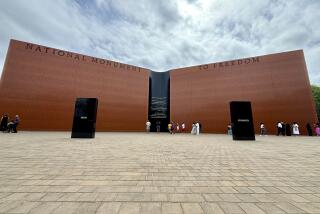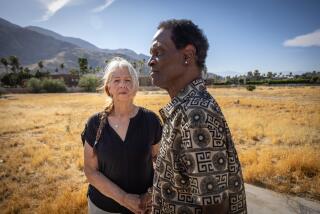The road to Selma: Remembering the stories of true American heroes
- Share via
On March 7, 1965, Charles Mauldin was a black teenager standing in the front ranks of civil rights marchers who crossed Selma’s Edmund Pettus Bridge only to be met by a phalanx of police and deputized members of the Ku Klux Klan who violently pushed them back. Mauldin remembers clambering down from the bridge to reach the river below and escape from the swinging clubs, the deputies charging on horseback, the guns and the clouds of tear gas.
Next weekend, Mauldin will return to the bridge in very different circumstances. He will be among tens of thousands of other celebrants, including President Obama, former-President George W. Bush and a host of senators and House members, all gathered to commemorate the 50th anniversary of the Selma march. The events surrounding what is now called Bloody Sunday have already been brought back to national attention by the Academy Award-nominated film “Selma” and by “Glory,” the Oscar-winning song from the movie written and performed by Common and John Legend. But there is nothing like hearing about history from the men and women who paid a steep price to live through it.
I had the privilege of meeting Charles Mauldin on Saturday night in a performing arts center at the University of Alabama in Tuscaloosa when he spoke with a group of 52 students, faculty and a diverse group of older adults representing my alma mater, the University of Washington, as well as two other schools, Bellevue College and Utah State University. I am part of that group -- 52 Strong, as we call ourselves -- riding a bus together on a nine-day civil rights pilgrimage through Alabama, Tennessee, Mississippi and Arkansas that will climax with the mass gathering in Selma.
Throughout the week, I will provide some insights into an important story that is not properly remembered. It is a hugely vital part of American history that could slip from our collective national memory as the people who lived through those times half a century ago pass from among us.
Mauldin was the first of many veterans of the civil rights movement who will be telling their stories to our group. He talked about growing up in an Alabama where black men were faced every day of their lives with a horrible choice: when confronted by white authority figures who sought to harass or humiliate or even do harm, a black man could either stand up like a man and be cut down or do nothing and live to raise a family.
Mauldin recalled that, in those times, black people were not only denied the vote, they were denied more prosaic rights; the right to sit at a lunch counter, to take any seat on a bus, to drink from the same water fountain as whites, to try on clothes and shoes at a store, to look a white person in the eye. And he recalled the sickening sound of a policeman’s club crushing down on the skull of nonviolent people trying to exercise their right to assemble and walk to their state capital and petition their government.
It may seem as though those bleak aspects of Southern segregation and Jim Crow are so familiar that it is not a remarkable or necessary thing to recount them, but, as I learned in a discussion circle after Mauldin finished his presentation, history is only one generation away from being forgotten.
The several black University of Alabama students I talked with all said their grandparents who lived through the dark days of segregation never talked about it, never shared their stories with their grandchildren. They had buried away the pain and shame they experienced and were not eager to dig it up again. The students also told me the history of Alabama they were taught at school was sketchy and sanitized. Yes, they heard about Rosa Parks and Martin Luther King Jr., but not very much about the horrific social conditions that caused people such as Parks and King to stand up and say, “No more.”
To my surprise, Mauldin said that evening in Tuscaloosa was the first occasion he had been so public about his own story. Until now, the experiences seemed too troubling to recount, he said, but he had come to realize those memories were too important not to share.
The next day, our bus rolled on to Montgomery, the state capital. Montgomery boasts that it is the most historical city in America; the place where the Confederacy was born in 1861 and where the Selma march finally reached its conclusion in 1965. The town is full of tributes to the Confederate past, but when local people wanted to put up markers taking note of Montgomery’s history as the center of the Southern slave trade, they had to overcome resistance from business leaders, city officials and the Alabama Historical Commission. Some people, apparently, have a preference for historical amnesia.
One of the most infamous moments in the city’s history came in May 1961 when the Freedom Riders rolled into town. These were groups of young men and women -- mostly students, both black and white, all trained in nonviolence -- who rode buses into the heart of Dixie, challenging segregation of the bus stations. In Montgomery, they were met by a violent mob of whites who, led by the KKK and given a green light by city police, savagely attacked the nonviolent riders.
The old Greyhound station where this incident occurred has been turned into small museum dedicated to the Freedom Riders. It’s a fine example of historic preservation and public education, yet state support has dwindled. Thanks to that official neglect, the museum may be shut down permanently after all the Selma hoopla recedes.
On a sign outside the museum there are these words: “This building stands as a testament to 438 ordinary people who did an extraordinary thing. They risked their lives and their freedom to bring justice to our nation.”
That gets to the heart of why the museum needs to stay open, why historical markers need to be erected, why schoolbooks need to tell a fuller story and why memories must be shared. The 438 and the thousands of others who took part in the civil rights movement were, indeed, mostly ordinary people showing extraordinary courage. Not since 1776 have there been patriots any more important to the fulfillment of the American claim of liberty and justice for all. And the fact that so many of these heroes are still alive makes it crucial that we listen to their stories while they are still with us.
More to Read
A cure for the common opinion
Get thought-provoking perspectives with our weekly newsletter.
You may occasionally receive promotional content from the Los Angeles Times.











